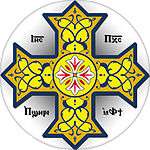Nayrouz
Nayrouz or Neyrouz (Arabic ناروز Nārūz < Persian نوروز Nawruz) is a feast when martyrs and confessors are commemorated within the Coptic Orthodox Church. Celebrated on September 11, the day is both the start of the Coptic new year and its first month, Thout.

The Feast of Nayrouz marks the first day of the Coptic year. Multiple theories have been proposed for the origin of the word. One popular theory, repeated on many Websites, is that the word is Egyptian in origin: Ignorant of the Egyptian language for the most part, the Arabs confused the Egyptian new year's celebrations, which the Egyptians called the feast of Ni-Iarōou (Bohairic ⲛⲓ-ⲓⲁⲣⲱⲟⲩ lit. the feast of the rivers), with the Persian feast of Nowruz,[1] from which the word Nayrouz etymologically comes. The misnomer remains today, and the celebrations of the Egyptian new year on the first day of the month of Thout are known as the Nayrouz. Others dispute this view, and hold that the word is fully Persian. They note that the word Nayrouz does not occur anywhere in the Synaxarium, that there is no evidence of the use of the supposed Coptic etymon in historical sources, and that a Persian etymology sufficiently explains the current name. The recorded Bohairic name for the new year was ⲡⲓⲭⲗⲟⲙ ⲛ̀ⲧⲉϯⲣⲟⲙⲡⲓ pi-klhom inte-tirompi, "the crown of the year."[2][3]
During the reign of Khosrow II (r. 590–628), the Persians reached Egypt for the second time in history, and established control for a decade (Sasanian Egypt).[4] According to Touraj Daryaee, the celebration of Nayrouz in Egypt may be one of the lasting Sasanid influences in Egypt.[4]
Its celebration falls on the 1st day of the month of Thout, the first month of the Egyptian year, which for AD 1901 to 2098 usually coincides with 11 September, except before a Gregorian leap year when it begins September 12.
The Coptic year
The chronology of the Coptic Orthodox Church begins when Diocletian became Roman emperor in 284 AD. His reign was marked by torture of Christians to force them to deny their faith, as well as by mass executions, especially in Egypt. It is believed this time was one of the worst times that the Coptic church faced, known to believers as "the martyrdom era". Hence, the Coptic year is identified by the abbreviation A.M. (for Anno Martyrum or "Year of the Martyrs"). It should not be confused with the A.M. abbreviation used for the unrelated Jewish year, which is Anno Mundi ("year of the world").
See also
- Coptic Calendar
- Copts
- Coptic Orthodox Church
- Sasanian Egypt
References
- "Freecopts.net". freecopts.net. Archived from the original on 2015-10-17. Retrieved 2018-03-14.
- "The Coptic Syndrome of Trying to Find Coptic Origins to Arab Words: Nayrouz as an Example". On Coptic Nationalism فى القومية القبطية. Retrieved 11 September 2018.
- "Resources". copticsounds. Retrieved 11 September 2018.
- Daryaee, p. 1.
Sources
- Daryaee, Touraj. Middle Persian Papyri from the Sasanian Occupation of Egypt in the Seventh Century CE (I) (PDF). Sasanika. Archived from the original (PDF) on 2017-07-09. Retrieved 2019-04-02.CS1 maint: ref=harv (link)